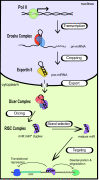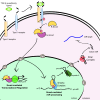Regulation of MicroRNA Biogenesis: A miRiad of mechanisms
- PMID: 19664273
- PMCID: PMC3224893
- DOI: 10.1186/1478-811X-7-18
Regulation of MicroRNA Biogenesis: A miRiad of mechanisms
Abstract
microRNAs are small, non-coding RNAs that influence diverse biological functions through the repression of target genes during normal development and pathological responses. Widespread use of microRNA arrays to profile microRNA expression has indicated that the levels of many microRNAs are altered during development and disease. These findings have prompted a great deal of investigation into the mechanism and function of microRNA-mediated repression. However, the mechanisms which govern the regulation of microRNA biogenesis and activity are just beginning to be uncovered. Following transcription, mature microRNA are generated through a series of coordinated processing events mediated by large protein complexes. It is increasingly clear that microRNA biogenesis does not proceed in a 'one-size-fits-all' manner. Rather, individual classes of microRNAs are differentially regulated through the association of regulatory factors with the core microRNA biogenesis machinery. Here, we review the regulation of microRNA biogenesis and activity, with particular focus on mechanisms of post-transcriptional control. Further understanding of the regulation of microRNA biogenesis and activity will undoubtedly provide important insights into normal development as well as pathological conditions such as cardiovascular disease and cancer.
Figures




Similar articles
-
MicroRNA in Cancer: The Involvement of Aberrant MicroRNA Biogenesis Regulatory Pathways.Genes Cancer. 2010 Nov;1(11):1100-14. doi: 10.1177/1947601910396213. Genes Cancer. 2010. PMID: 21533017 Free PMC article.
-
Control of microRNA biogenesis by TGFbeta signaling pathway-A novel role of Smads in the nucleus.Cytokine Growth Factor Rev. 2009 Oct-Dec;20(5-6):517-21. doi: 10.1016/j.cytogfr.2009.10.004. Epub 2009 Nov 4. Cytokine Growth Factor Rev. 2009. PMID: 19892582 Free PMC article. Review.
-
Many roads to maturity: microRNA biogenesis pathways and their regulation.Nat Cell Biol. 2009 Mar;11(3):228-34. doi: 10.1038/ncb0309-228. Nat Cell Biol. 2009. PMID: 19255566 Review.
-
miRiaD: A Text Mining Tool for Detecting Associations of microRNAs with Diseases.J Biomed Semantics. 2016 Apr 29;7(1):9. doi: 10.1186/s13326-015-0044-y. J Biomed Semantics. 2016. PMID: 27216254 Free PMC article.
-
Target RNAs Strike Back on MicroRNAs.Front Genet. 2018 Oct 2;9:435. doi: 10.3389/fgene.2018.00435. eCollection 2018. Front Genet. 2018. PMID: 30333855 Free PMC article. Review.
Cited by
-
Heavy and light roles: myosin in the morphogenesis of the heart.Cell Mol Life Sci. 2013 Apr;70(7):1221-39. doi: 10.1007/s00018-012-1131-1. Epub 2012 Sep 6. Cell Mol Life Sci. 2013. PMID: 22955375 Free PMC article. Review.
-
miRNA control of tissue repair and regeneration.Am J Pathol. 2015 Oct;185(10):2629-40. doi: 10.1016/j.ajpath.2015.04.001. Epub 2015 Jun 6. Am J Pathol. 2015. PMID: 26056933 Free PMC article. Review.
-
Cobalt(III) Protoporphyrin Activates the DGCR8 Protein and Can Compensate microRNA Processing Deficiency.Chem Biol. 2015 Jun 18;22(6):793-802. doi: 10.1016/j.chembiol.2015.05.015. Chem Biol. 2015. PMID: 26091172 Free PMC article.
-
Microprocessor of microRNAs: regulation and potential for therapeutic intervention.Mol Cancer. 2010 Jun 1;9:134. doi: 10.1186/1476-4598-9-134. Mol Cancer. 2010. PMID: 20515486 Free PMC article. Review.
-
Extracellular Vesicles as Novel Drug-Delivery Systems through Intracellular Communications.Membranes (Basel). 2022 May 25;12(6):550. doi: 10.3390/membranes12060550. Membranes (Basel). 2022. PMID: 35736256 Free PMC article. Review.
References
LinkOut - more resources
Full Text Sources
Other Literature Sources

